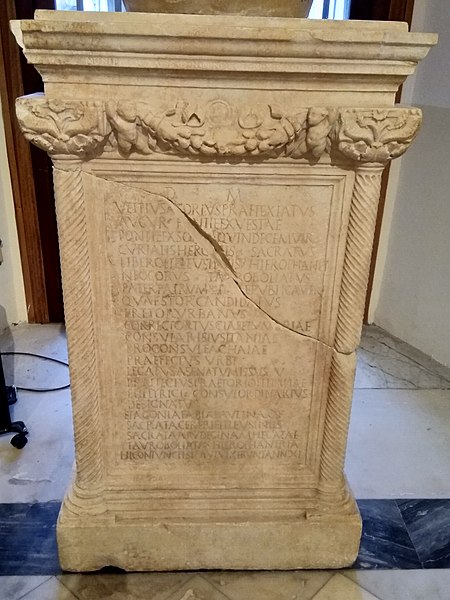Sappho's poetry originate a long list of women who, until the 4th century AD, captured their voices in various styles, both in Greek and Latin. From the Roman period, and mentioning only the poets of whom a minimum testimony remains, we find Sulpicia 'the elegiac', Melinno, Herenia Procula, Claudia Trofime, Sulpicia 'the satirist', Julia Balbilla, Caecilia Trebulla, Damo, Terentia, Theosebia and Aconia Fabia Paulina.

Aconia Fabia Paulina
Roma; c. 300 — c. 384
Període d'activitat: 315 — 384
Classificació geogràfica: Europa > Itàlia
Moviments socio-culturals
Antiguitat > Cultura romana > Imperi
Grups per àmbit de dedicació
Escriptores > Poetes
Escriptores > en > llatí
Context de creació femenina
Ressenya
Roman poet and aristocrat of the 4th century AD. Like her husband, she occupied a prominent position in the defense of the mystical and oriental cults of the Roman religion. Although she has always been related to him in the public sphere, she was an influential person in the private and religious sphere. She has left us forty-one iambic senarius in a laudatio funebris, commemorating the loss of a loved one and that of the pagan Rome.
Activitats
Justificacions
Biografia
She was the daughter of an aristocrat who held the offices of prefect and consul. She married Vetius Agorius Praetextatus in 344 AD, resided on the Palatine Hill and had a son or daughter. Vetius Agorius belonged to the Roman senatorial aristocracy and was one of the great figures of the pagan intellectual movement of the 4th century and a referent in the opposition to Christianity. Paulina was also part of pagan circles; she was initiated into the Eleusinian and Lernian mysteries of Dionysus and Demeter, and was committed to several female deities, such as Ceres, Hecate (of whom she was a hierophant), the Magna Mater (as a tauroboliata) and Isis.
In the Capitoline Museums, a marble base is preserved that would be part of the funerary monument of both. On the front of the pedestal, there is a list of religious offices and the husband's cursus honorum, followed by details of Paulina's religious offices. On both sides, the husband's praise for Paulina is written. On the back, Paulina's verses, forty-one iambic senarius, celebrating her husband and love are engraved; possibly the poem is the laudatio funebris read at her husband's funeral. In those verses, she cries for the loss of a loved one, but also that of pagan Rome; Paulina's verses invoke the Greco-Roman gods for the last time.
After the death of Praetextatus, in 384 AD, Concordia, the last vestal, promoted the erection of a statue in his honor because he had been a priest and protector of the College of the Vestals. In turn, Paulina, erected one for her, as a token of her gratitude.
After Paulina's death c. 384 AD, her descendant dedicated a funerary monument with statues to them in their home.
Bibliografia
-Kahlos, Maijastina (1994). "Paulina and the Death of Praetextatus", in Arctos 28, pp. 13-25, (retrieved on 11-10-2021). <https://web.archive.org/web/20071024183849/http://www.maijastinakahlos.net/b/kirjoituksia/praetextatus/paulina-and-the-death-of-praetextatus-arctos-28-1994/>
-Lopez, Aurora (1994). No sólo hilaron lana. Escritoras romanas en prosa y verso. Madrid: Ediciones Clásicas, pp. 75-94.
-Luque, Aurora (2020). Grecorromanas. Surviving lyric from classical antiquity. Barcelona: Ed. Planeta, pp. 206-218.
-Pavón Pilar (dir.) (2022). “Exposición Virtual: 250 mujeres de la antigua Roma” en Conditio feminae I: Marginación y visibilidad de la mujer en el Imperio Romano. Universidad de Sevilla, (retrieved on 21/11/2022),<https://grupo.us.es/conditiofeminae/index.php/2022/04/05/fabia-aconia-paulina/>
Enfocament Didàctic
-CUC: Block Classical roots of today's world. Everyday life; Block Continuity of cultural heritage. Literature, art and science.
-Latin 4th ESO: Block Latin text and translation; Block Legacy and heritage;
-Latin Baccalaureate: Block The text: comprehension and translation; Block Literary education.
-Universal Literature 1st Baccalaureate: Interpretation of fragments from the Roman period of different genres and themes.
-Spanish Language and Literature ESO: Literary Education Block.